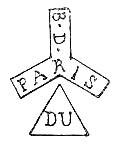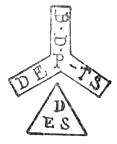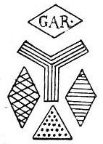|
BIGORNE

In order to prevent and detect fraud of hallmarked silver
articles, French authorities instituted, by Ordinance of 1st July
1818, a system of countermarks on the opposite side of the
guarantee mark. These countermarks are known as "bigornes".
The term bigorne literally means two-horned anvil or two-beaked
anvil and refers to the shape of the projecting ends of the
anvil. Each anvil has two striking areas, one flat and one of
rounded shape. The rounded horn served to mark hollowware and
the flat horn was used to mark flatware.
|
The projecting ends of the small anvil were intricately
engraved with varied and finely drawn representations of insects.
The silver article was placed on the beak/horn of the steel
anvil and when the guarantee mark was struck, the force of the
strike created a counter-impression of insects on the underside
of the article against the anvil.
BIGORNES INTRODUCED BY ORDINANCE OF 1ST JULY 1818 AND USED FROM
AUGUST 1819 TILL MAY 1838
There are three sizes of bigorne marks, having randomly arranged
insects on a plain background, except for the small bigorne
which had both a rounded and a flat end.
1. The large bigorne with a horn on which the six different
insects are engraved inside various frames (triangle, pentagon,
indented parallelogram, lozenge, etc).
2. The medium-sized bigorne with a horn bearing engraved insects,
but not so many as on the large bigorne. Both bigornes are the
same for Paris as for the Provinces.
 |
 |
 |
 |
 |
 |
 |
Notoxus
|
Conops
|
Saperde
|
Grasshopper
|
Pantatome
|
Bibion
|
Saperde & Bibion
|
 |
 |
 |
 |
 |
 |
. |
3. The small bigorne with two horns, one flat and the
other rounded, bearing engraved triangles and lozenges with
linear designs and letters.
 |
 |
 |
Paris
|
Provinces
|
Common for Paris and Provinces
|
BIGORNES INSTITUTED BY A DECREE OF 30th JUNE 1835, PUT IN
USE ON 9th MAY 1838 (MODIFIED IN DECEMBER 1846)
This system is even more sophisticated than the preceding one,
because the insects are engraved aligned in relief and separated
by parallel zigzag moulded borders. This series was further
distinguished by having one set for Paris and another set for
the Provinces.
The surface of the anvil is covered with varied and finely drawn
engravings of various insects which mark the underside of the
silver article when it is struck on the upper side with the
guarantee mark. The assayer placed the item on the horn of the
anvil, then placed the Minerva (or other) punch on the item, and
struck the Minerva punch with a mallet. Through the force of
the strike both marks were created simultaneously. For this
reason a bigorne mark will be found opposite the guarantee mark.
The bigorne dies are so complex that two similar strikes could
not be obtained.
There are three types of bigorne used according the object size:
large (16 bands), medium (13 bands) and small (21 bands). The
rounded horn and the flat horn are used depending on the shape
of the article to be marked.
For Paris the insects are shown in profile:
For the Provinces (Départements) the insects are
presented in bird's eye view
The borders separating the bands of insects are hollow
except on the medium sized bigorne and on the rounded horn of
the small bigorne. In these cases the tiny grooves are covered
with dots; these serve as a support in the marking of very thin
articles and also prevent the marks to appear only on the
surfaces resting on the insects.
The Article 185 of Appendix III of the French General Tax Code (which
introduced the insect-engraved bigornes in use from 1838) was
officially abrogated on 16 July 1984 by the Article 9 of Decree
No. 84-623. resting on the insects.
(courtesy Robert Massart/ASCAS)

www.silvercollection.it |
This is a page of A Small Collection of
Antique Silver and Objects of vertu, a 1500 pages richly illustrated website offering all you need to know about
antique silver, sterling silver, silverplate, Sheffield plate, electroplate silver,
silverware, flatware, tea services and tea complements, marks and hallmarks, articles,
books, auction catalogs, famous silversmiths (Tiffany, Gorham, Jensen, Elkington),
history, oddities ...
HOME - SITE MAP - SILVER DICTIONARY - COOKIES CONSENT AND PRIVACY
OTHER ARTICLES ABOUT: ANTIQUE SILVER
SILVER PLATE
ENGLISH SILVER
FRENCH SILVER
|
| |